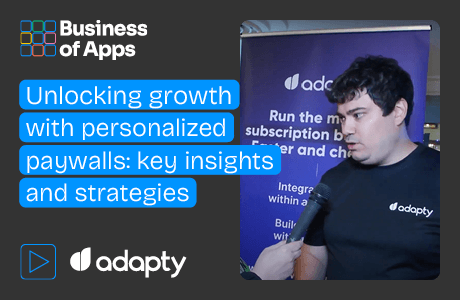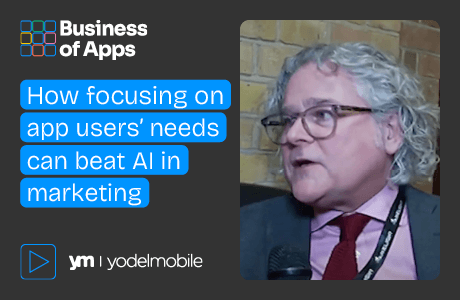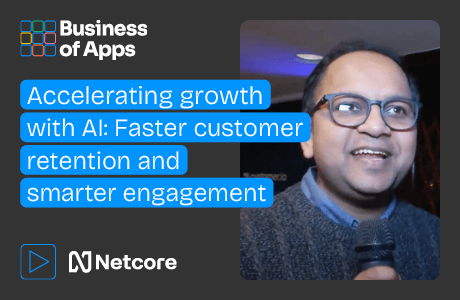
In this week’s Business of Apps podcast episode, we sat down with Dieter Rappold, CEO and co-founder of ContextSDK, to explore a powerful shift in how mobile apps are built and optimized. Instead of relying solely on what users have done in the past, Dieter and his team are helping app developers focus on what users want right now—their real-time intent.
In this article, we unpack the core ideas from that conversation and explore how intent-based personalization, powered by on-device AI, is setting a new standard for engagement, retention, and monetization—without compromising on privacy.
From personalization to contextualization
For years, app personalization has been based on historical data—demographics, segments, and past behavior. But that approach is static. ContextSDK makes a compelling case that user needs shift from moment to moment, and apps should adapt accordingly.
As Dieter explained, “It’s great to know a lot about past behavior, but past behavior is looking into the past. Intent is happening in the moment and is looking forward.”
ContextSDK captures over 200 real-world signals from smartphones—mostly from sensors like the accelerometer and gyroscope, but also including battery state, screen usage, and motion data. This allows apps to shift from generic personalization to what Dieter calls “360-degree contextually”—a deeper understanding of what the user is doing right now, and why.
How ContextSDK works
At its core, ContextSDK harnesses on-device sensors to gather motion patterns, device orientation, and other environmental clues. The data is processed locally using machine learning models, enabling apps to infer whether a user is walking, sitting, commuting, or stationary.
“We collect enough data points on patterns of movement and behavior and analyze them with the smartest machine learning models out there. That allows us to infer intent—and that’s something extremely powerful when shaping app experiences,” Dieter said.
What makes this more than just smart UX is the privacy-first architecture. “We are, at no point, collecting any personally identifiable information—ever,” he added. “It’s privacy by design.”
An app experience that adapts to the moment
Dieter highlighted a common challenge for fintech and crypto apps: long onboarding flows due to regulatory compliance. Users often start the process at the wrong time—while commuting, for example—and abandon it midway.
“With bad timing, users abandon onboarding processes. That’s quite a pity, especially in verticals with high customer acquisition costs,” he said.
ContextSDK lets apps detect this and either delay the prompt or suggest picking it up later when the user is home and focused. “We can say, ‘Hey, this process will take 10–12 minutes and you’ll need your passport—maybe continue later when you’re at your desk.’” If users abandon, the SDK can trigger a smart re-engagement push notification at the right time—when the user is in a better environment to finish the process.
A win for LiveOps teams
Live operations teams often play second fiddle to acquisition and monetization—but their role is increasingly vital.
“We believe that live ops teams are a critical success factor when it comes to increasing LTV across the user base,” Dieter noted. “With our product, you’re no longer pushing based solely on demographics—you’re adapting to the moment. That makes experiences feel personal without needing more personal data.”
In a saturated market with rising acquisition costs, optimizing post-install behavior and retention is becoming the main lever for growth. ContextSDK gives LiveOps teams a way to be proactive rather than reactive.
Privacy without compromise
In a world of increasing privacy regulation, ContextSDK was intentionally designed to be future-proof.
“We decided on a very disruptive architecture. We’re sending abstracted context information to our server to improve our models, but they can never be tied to a unique user ID or device ID,” Dieter emphasized.
This makes the SDK compliant with regulations like GDPR out of the box—offering personalization without the traditional trade-offs.
Developer-friendly by default
As a long-time developer tool creator (he previously built Fastlane), Dieter’s co-founder Felix Krause brought a developer-first mindset to ContextSDK.
“Felix was very particular about making life easier for engineers. With just a few lines of code, you can integrate ContextDecision or ContextPush, start collecting signals, and be live in your next release cycle,” Dieter said.
This speed and simplicity make it accessible even for small teams that want to start testing adaptive flows without heavy investment.
Final thoughts
“It is high time to bring more intelligence to the device side,” Dieter said during our chat. “We’ve spent decades building smart apps through server-side logic. But the devices in our pockets today are packed with powerful sensors—and we’re only scratching the surface of what they can do.”
In a competitive, privacy-sensitive mobile landscape, adapting to real-time intent may be the edge that sets the best apps apart.
Want to learn more?
Dieter and the ContextSDK team will be hosting a roundtable discussion at the App Promotion Summit in London on April 25. You can also connect with him via LinkedIn or email him at dieter@contextsdk.com and download their recent case study – Unlock revenue with smarter timing.
Catch the full conversation in this week’s Business of Apps podcast episode:









